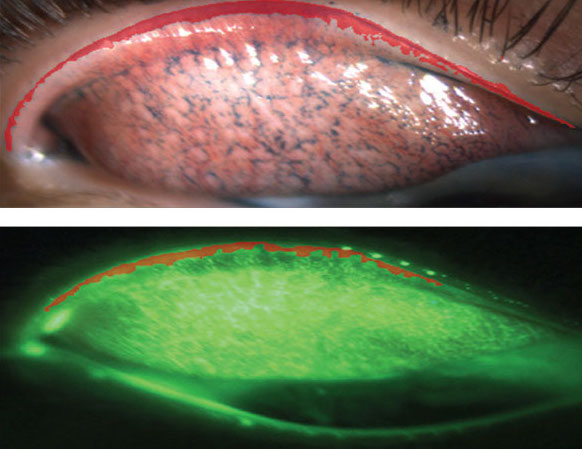 |
| In this study, higher comfort scores after 14 hours of soft contact lens wear were associated with lower levels of upper eyelid margin staining. Photo: Chris Lievens, OD. Click image to enlarge. |
Studies and surveys have shown that discomfort is the leading reason individuals discontinue contact lens (CL) wear. In searching for clinical parameters that may be associated to this discomfort, researchers recently identified several that could distinguish between soft CL wearers who experienced symptoms of ocular surface discomfort after a day of wear and those who didn’t. In the two-phase investigation, upper eyelid margin staining (a.k.a. lid wiper epitheliopathy) and lower tear meniscus height were most effective in differentiating symptomatic from asymptomatic wearers. The study was funded by Johnson & Johnson but the company’s products were not used in the research.
Phase 1 (n=161) of the investigation consisted of identifying asymptomatic (CLDEQ-8 score ≤7) and highly symptomatic (CLDEQ-8 score ≥20) patients who were established wearers of soft contact lenses. In Phase 2 (n=42; 25 asymptomatic and 17 symptomatic subjects), researchers measured the following parameters after 14(±2) hours of lens wear, which were then compared between the two groups: blinking characteristics, tear meniscus height, non-invasive tear break-up time, tear film osmolarity and eyelid margin staining.
The researchers made the following observations from the data:
- In symptomatic CL wearers, lower eyelid tear meniscus height was decreased after 14 hours compared with asymptomatic subjects (least square mean [LSM] difference: -0.04mm).
- At initial fitting, osmolarity was lower in symptomatic than in asymptomatic subjects (LSM difference: -9.89).
- Upper eyelid margin staining was greater in symptomatic than in asymptomatic subjects after 14 hours (LSM difference); this parameter was also greater after 14 hours than at baseline in the symptomatic group (LSM difference).
- There was a significant relationship between comfort and upper eyelid margin staining (r=−0.40) and blink rate (r=−0.31).
The researchers were able to rationalize most of these findings. For one, they noted in their paper on the study that blink rate “is known to increase with CL wear compared with no-lens wear. This was shown in the current work by an increase in the blink rate from pre-lens baseline (LSM 19 blinks/minute) to post-lens fitting (LSM 24 blinks/ minute) and again from fitting to 14 hours (LSM 28 blinks/minute).” They added, “This also suggests that the blink rate increases with greater discomfort.”
The researchers also elaborated on the finding of lower tear meniscus height after lens wear in symptomatic wearers: “The tear meniscus height gives a direct indication of the tear meniscus volume. Reduced tear volume is likely to lead to inadequate lubrication between the eyelid margin conjunctival epithelium and the lens surface, which may ultimately result in both visual and comfort problems.”
Soft lens wear was also found to decrease non-invasive TBUT in both asymptomatic and symptomatic patients at fitting and 14 hours compared with baseline; however, no differences were noted between the two groups. The parameter also wasn’t correlated with comfort scores, although the researchers pointed out that “reduced tear break-up time has been associated with increased symptoms of discomfort in previous studies.”
One finding from this study that is inconsistent among the literature, the researchers note, is the significant increase in upper eyelid margin staining observed in symptomatic patients after contact lens wear. Another is the association between higher staining scores and reduced levels of comfort, though the researchers argued in their paper that the studies that failed to find an association likely did so “as a result of a lack of statistical power or problems with methodology.”
Limitations of this study include the use of only one lens brand and the assessment of only one day of CL wear. The study authors noted, “More complex methodologies of assessment may be needed to elucidate fully the underlying mechanisms of CL discomfort including employing larger sample sizes to validate the results from this pilot investigation.”
Maldonado-Codina C, Navascues-Cornago M, Smith SL, Read ML, Lakkis C, Morgan PB. End-of-day assessment of asymptomatic versus highly symptomatic soft contact lens wearers. Ophthalmic Physiol Opt. March 28, 2024. [Epub ahead of print]. |


